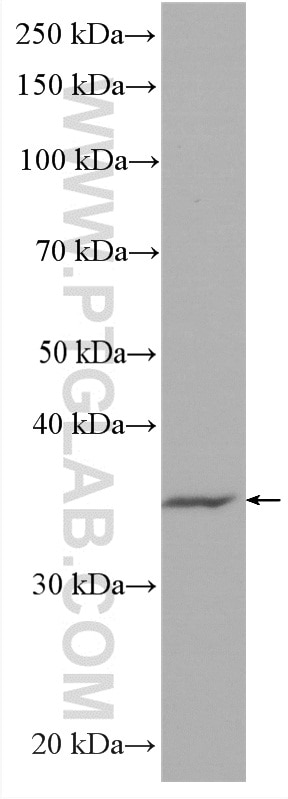TYMS Monoklonaler Antikörper
TYMS Monoklonal Antikörper für WB
Wirt / Isotyp
Maus / IgG1
Getestete Reaktivität
human
Anwendung
WB
Konjugation
HRP Fluorescent Dye
CloneNo.
1F5B7
Kat-Nr. : HRP-66725
Synonyme
Galerie der Validierungsdaten
Geprüfte Anwendungen
| Erfolgreiche Detektion in WB | Jurkat-Zellen |
Empfohlene Verdünnung
| Anwendung | Verdünnung |
|---|---|
| Western Blot (WB) | WB : 1:5000-1:20000 |
| Sample-dependent, check data in validation data gallery | |
Produktinformation
HRP-66725 bindet in WB TYMS und zeigt Reaktivität mit human
| Getestete Reaktivität | human |
| Wirt / Isotyp | Maus / IgG1 |
| Klonalität | Monoklonal |
| Typ | Antikörper |
| Immunogen | TYMS fusion protein Ag7027 |
| Vollständiger Name | thymidylate synthetase |
| Berechnetes Molekulargewicht | 36 kDa |
| Beobachtetes Molekulargewicht | 36 kDa |
| GenBank-Zugangsnummer | BC002567 |
| Gene symbol | TYMS |
| Gene ID (NCBI) | 7298 |
| Konjugation | HRP Fluorescent Dye |
| Form | Liquid |
| Reinigungsmethode | Protein-G-Reinigung |
| Lagerungspuffer | BS mit 50% Glyzerin, 0,05% Proclin300, 0,5% BSA, pH 7,3. |
| Lagerungsbedingungen | Bei -20°C lagern. Vor Licht schützen. Nach dem Versand ein Jahr stabil. Aliquotieren ist bei -20oC Lagerung nicht notwendig. 20ul Größen enthalten 0,1% BSA. |
Hintergrundinformationen
Thymidylate synthase gene (TYMS) encodes thymidylate synthase (TS) which is an important factor in the growth of tumor cells. TS can catalyze the transformation of intracellular uridine monophosphate (dump) into dTMP which is required for DNA replication and repairing. TS is a key enzyme in the process of cell proliferation, also is the important target enzymes of 5-FU and other chemotherapy drugs. The expression of TYMS is negatively correlated with the efficacy of chemotherapy and the prognosis of patients who suffer from rectal cancer, breast cancer, colorectal cancer, gastric cancer, head and neck cancer, esophageal cancer, pancreatic cancer and so on.
Protokolle
| Produktspezifische Protokolle | |
|---|---|
| WB protocol for HRP TYMS antibody HRP-66725 | Protokoll herunterladen |
| Standard-Protokolle | |
|---|---|
| Klicken Sie hier, um unsere Standardprotokolle anzuzeigen |


